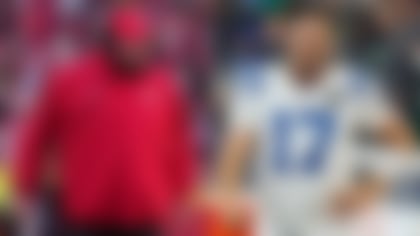There are multiple factors that go into free agent signings, like team need, contract cost and player preference -- and all must be carefully considered by teams in order to determine the potential consequences an addition will have on the entire roster. Ahead of what could be one of the most interesting free agency periods to date, it's worth taking a look at where some of the biggest names would add the most wins to a team in need next season.
The method I used to create an analytics-based perspective on where some of the most notable free agents would have the greatest impact next season was to measure which team they'd add the most wins to in 2020. I took my win-share model -- which, as explained here, is built around the number of times a player impacts first downs and touchdowns that lead to wins or losses, either by creating such first downs and touchdowns on offense or by preventing them on defense -- and matched the free agents with all the teams with needs at their position. Using each team's current roster (and what's missing from it), this model maximizes where each free agent would add the most wins in 2020, also taking into account scheme fit and cap space (per Over The Cap).
Like I said, there are a lot of considerations in free agent signings. This is just one lens to look through -- where some of the biggest free agents project to add the most wins in 2020 given what we know right now. A team could use a model like this in conjunction with other tools to help evaluate the overall free agency landscape and create a strategy for targeting optimal players at a cost that works for their cap situation.
Tom Brady, QB: New England Patriots (4.1 wins)
I realize, as we wait to find out where the GOAT is going, this isn't the flashiest potential fit. But Brady is obviously familiar with the Patriots' system, and New England will have the chance to patch roster holes in free agency and the draft (maybe adding a perimeter threat wideout, offensive line help and perhaps a tight end). Factoring in all those considerations, along with presence of the top-ranked defense in 2019 and the in-game play-calling advantage that Bill Belichick and offensive coordinator Josh McDaniels bring to the sideline, Brady's ability to execute the Pats' complex game plan maximizes their win potential next season.
Interestingly, Brady also projects to have a 4.0 win share with the Colts, who would be an excellent match, thanks to the strength of their offensive line, especially on the interior. With a projected $86 million in cap space (second-most in the NFL), they can re-sign free-agent left tackle Anthony Castonzo and still afford a premium Brady contract. Further, last season, the Pats ranked sixth in passer rating on attempts of 20-plus air yards (107.6), despite only attempting 54 deep passes (ranked 21st), per Next Gen Stats. Keeping Brady away from pressure will allow him to combine his quick passing efficiency with the right kinds of deep passes to create first downs and touchdowns at a rate that would go a long way to help the Colts, especially in the AFC South.
Philip Rivers, QB: Tampa Bay Buccaneers (3.6 wins)
During Rivers' final season with the Chargers, his wide receivers averaged just 2.4 yards of separation at the time of pass arrival, which ranked second-to-last in the NFL, according to NGS. This means the passes Rivers threw had to be incredibly precise -- and it also helps explain his uptick in interceptions in 2019, when he threw 20 picks, from 2018 (when he had 12, and Bolts WRs averaged 2.6 yards of separation) and '17 (when he had 10, and they ranked sixth with 2.9), as less separation typically leads to more turnovers. Further, injuries to tight ends and offensive linemen have hamstrung Rivers over the past several seasons. Tampa Bay's receivers averaged 13.9 air yards per target last season (best in the NFL, per NGS). One way to read my model here is that the data says it's more probable the 38-year-old Rivers will execute a high-volume passing game with fewer turnovers in Bruce Arians' system in Tampa. Upgrading the 24th-ranked run game -- which the Bucs should be able to do, given they currently have the fourth-most projected cap space at $79.9 million -- would help any potential quarterback.
Amari Cooper, WR: Carolina Panthers (0.8 wins)
In 25 games with Dallas (from Week 9 of the 2018 season through Week 17 of last year), Cooper caught 67.4 percent of his targets, with 14 touchdown receptions (tied with Michael Thomas and Julio Jones for the most in that time span). Last season, Panthers receivers averaged only 1.2 yards run per route, which ranked 31st in the NFL, per NGS. The impact Cooper would have in terms of both serving as a deep target and driving better opportunities for his teammates (ahem, creating more space for dynamic running back Christian McCaffrey) is what drives his value. Consider that from the start of the 2017 season until Cooper joined the team in 2018, Dallas' offense logged 50 passes of 20-plus yards, tied for fewest in the NFL in that span; over the past 25 games with Cooper, the Cowboys recorded 91 such passes, sixth-most in the NFL, with 21 going for touchdowns (second-most in the NFL). The shape of the Panthers' offseason strategy -- in light of quarterback Cam Newton's somewhat murky status and the recent decision to trade away guard Trai Turner -- remains unknown. But if they want to add an offensive piece who could help them win, Cooper would fit the bill.
Jadeveon Clowney, EDGE: Seattle Seahawks (1.5 wins)
I think it's likely Seattle will end up locking down Clowney after trading to acquire him from the Texans last offseason. When the former first overall pick is fully healthy, it's easy to see why a team wouldn't want to let him out of its grasp. Last season, when he was on the field (398 pass-rushing snaps), the Seahawks' pressure rate was 24.6, and their sack rate was 4.8, per NGS; when he wasn't on the field (228 pass-rushing snaps), Seattle only managed a 17.5 pressure rate and a 3.9 sack rate. The fact that there are many other potential changes in the works along their defensive line (with Jarran Reed and Al Woods also headed to free agency) gives the Seahawks the slight win-share edge over the Bengals, Giants and Dolphins (all are at about 1.4) when it comes to projecting Clowney's impact on their team.
Byron Jones, CB: Jacksonville Jaguars (1.3 wins)
Corners are likely going to command high salaries in this market, as it seems there aren't many bound to reach free agency, and the draft class doesn't appear to be exceptionally deep at this position. Since 2018, Jones has forced a tight window on 44.1 percent of targets as the nearest defender -- he's the only defender with 100-plus targets faced to have an average above 35 percent. Within the past five months, the Jaguars have parted ways with high-profile corner Jalen Ramsey and 2017 signee A.J. Bouye, so adding to their defensive backfield is a must. Jacksonville ever so slightly edged out the Raiders (1.29 wins added) and Giants (1.25 wins added) and Jets (1.24 wins added) when projected Jones' impact.
Some quick notes:
1)Yannick Ngakoue adds between 1.15 and 1.25 wins for five different teams, which says a lot about both his value and the market for pass rushers. It's likely that his age (he's turning 25 on March 31) will be a positive driver for his contract situation. The Bengals, Dolphins, Raiders, Seahawks and Falcons all would see a big gain with his presence. The demand at Ngakoue's position might give the Bucs more reason to figure out how to retain free agent Shaquil Barrett, who posted a league-high 19.5 sacks last season -- especially when you consider that the Jags could keep Ngakoue from the market via the franchise tag.
2)Jameis Winston's production potential increases in the model more than it does for other QBs when he's projected with a team that has a reliable run game and a defense that decreases his probability of having to pass late in games. O-line problems aren't as detrimental to him as they are to other quarterbacks, though, as his 131.7 passer rating outside the tackle box ranked first among 32 qualified QBs last season. For what it's worth, Winston projects the best when paired with Drew Lock in Denver, splitting starter duties 50-50 with the second-year pro, perhaps in a scenario similar to what happened with Marcus Mariota and Ryan Tannehill on the Titans last year.
3)Ryan Tannehill projects for his highest win share if the Titans bring him and running back Derrick Henry back for 2020 (in such a scenario, Tannehill's win share would be 3.2, with a combined win share of 3.7 for Tannehill and Henry together). When I calculate his impact as a member of other teams, two squads stand out: the Bears and Jags (even though neither is very likely). This is partially because of the untapped efficiency at QB last season in Chicago and Jacksonville, though both squads also had underwhelming rushing efficiency in 2019. Tannehill's ability to navigate pressure is the main factor driving his value. According to NGS, Tannehill was pressured on 30.9 percent of dropbacks (the seventh-highest rate in 2019) but managed the best passer rating (112.4) and yards per attempt (10.4) under pressure, while also logging the second-highest completion percentage (64.2).
Follow Cynthia Frelund on Twitter @cfrelund.












